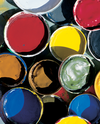Xfce 4.12 after almost three years
|
Better Tiling
In the context of a desktop, the word tiling refers to the division of windows in a pattern similar to floor tiling. The developers for Xfce 4.12 have improved the tiling for Xfwm significantly for situations when client-side decorations (CSDs) are utilized. The term CSD is specific to GTK3, and it refers to the capability of a program to decide on characteristics like the frame of a window by itself.
When CSDs are used, the programs are responsible for the window frames and the arrangement of buttons for closing and minimizing. Back when Xfce 4.10 was current, the topic of CSDs was not yet particularly relevant. Meantime, CSDs have become an important consideration for GTK3 applications. Xfwm 4.12 has now completely mastered tiling and the automatic arrangement of windows using CSDs.
The expanded CSD support led to funny situations in our test. For example, windows in focus have a different window decoration from those not in focus (Figure 2). At first, this is more irritating than useful, but it's easy to get used to.Likewise, automatic docking of windows on the edge of the display screen has undergone improvement for windows with CSDs and those without. Combining the Alt key with the mouse wheel lets you zoom in on individual windows.
 Figure 2: In the standard theme, windows in focus have a different decoration from windows without focus.
Figure 2: In the standard theme, windows in focus have a different decoration from windows without focus.
Large Displays, High Resolution
Finally, the developers have also worked on the topic of high resolution. This has been continually pertinent for desktop environments and is like a relic of the past. This is because developers and manufacturers created desktop environments for lower resolutions during the years which saw 15-inch display screens and the first LCD displays. This adaptation persists today, particularly because combinations like 23-inch display screens and full HD resolution are still desired by most users.
Those wanting to use higher resolution or smaller displays with the same resolution soon have a set of problems on their hands. Symbols and fonts are barely visible on a 23-inch display screen with 4K resolution.
And now, perhaps the biggest modification of Xfwm 4: The Windows Manager comes with two operating modes that have been specially created for the HiDiPi mode (Figure 3). These so-called themes have, for example, larger standard values for the size of the font used by the system. The user therefore gets the high depth of focus of LED displays with high resolution while retaining the ability to read all of the text and recognize all of the symbols. Xfwm is even further along in this regard than Mac OS X, because there is still no usable HiDiPi mode on OS X. The modifications made to Xfwm have all been successful.
Buy this article as PDF
Pages: 6
(incl. VAT)






